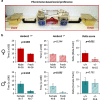Sexual dimorphism of AMBRA1-related autistic features in human and mouse
- PMID: 28994820
- PMCID: PMC5682605
- DOI: 10.1038/tp.2017.213
Sexual dimorphism of AMBRA1-related autistic features in human and mouse
Abstract
Ambra1 is linked to autophagy and neurodevelopment. Heterozygous Ambra1 deficiency induces autism-like behavior in a sexually dimorphic manner. Extraordinarily, autistic features are seen in female mice only, combined with stronger Ambra1 protein reduction in brain compared to males. However, significance of AMBRA1 for autistic phenotypes in humans and, apart from behavior, for other autism-typical features, namely early brain enlargement or increased seizure propensity, has remained unexplored. Here we show in two independent human samples that a single normal AMBRA1 genotype, the intronic SNP rs3802890-AA, is associated with autistic features in women, who also display lower AMBRA1 mRNA expression in peripheral blood mononuclear cells relative to female GG carriers. Located within a non-coding RNA, likely relevant for mRNA and protein interaction, rs3802890 (A versus G allele) may affect its stability through modification of folding, as predicted by in silico analysis. Searching for further autism-relevant characteristics in Ambra1+/- mice, we observe reduced interest of female but not male mutants regarding pheromone signals of the respective other gender in the social intellicage set-up. Moreover, altered pentylentetrazol-induced seizure propensity, an in vivo readout of neuronal excitation-inhibition dysbalance, becomes obvious exclusively in female mutants. Magnetic resonance imaging reveals mild prepubertal brain enlargement in both genders, uncoupling enhanced brain dimensions from the primarily female expression of all other autistic phenotypes investigated here. These data support a role of AMBRA1/Ambra1 partial loss-of-function genotypes for female autistic traits. Moreover, they suggest Ambra1 heterozygous mice as a novel multifaceted and construct-valid genetic mouse model for female autism.
Conflict of interest statement
The authors declare no conflict of interest.
Figures





Similar articles
-
Chemogenetic rectification of the inhibitory tone onto hippocampal neurons reverts autistic-like traits and normalizes local expression of estrogen receptors in the Ambra1+/- mouse model of female autism.Transl Psychiatry. 2023 Feb 20;13(1):63. doi: 10.1038/s41398-023-02357-x. Transl Psychiatry. 2023. PMID: 36804922 Free PMC article.
-
Neurodevelopmental Disorders: Functional Role of Ambra1 in Autism and Schizophrenia.Mol Neurobiol. 2019 Oct;56(10):6716-6724. doi: 10.1007/s12035-019-1557-7. Epub 2019 Mar 26. Mol Neurobiol. 2019. PMID: 30915711 Review.
-
Chemogenetic induction of CA1 hyperexcitability triggers indistinguishable autistic traits in asymptomatic mice differing in Ambra1 expression and sex.Transl Psychiatry. 2025 Mar 17;15(1):82. doi: 10.1038/s41398-025-03271-0. Transl Psychiatry. 2025. PMID: 40097399 Free PMC article.
-
AMBRA1, Autophagy, and the Extreme Male Brain Theory of Autism.Autism Res Treat. 2019 Oct 10;2019:1968580. doi: 10.1155/2019/1968580. eCollection 2019. Autism Res Treat. 2019. PMID: 31687209 Free PMC article.
-
Oxytocin, sexually dimorphic features of the social brain, and autism.Psychiatry Clin Neurosci. 2009 Apr;63(2):129-40. doi: 10.1111/j.1440-1819.2009.01944.x. Psychiatry Clin Neurosci. 2009. PMID: 19335381 Review.
Cited by
-
Chemogenetic rectification of the inhibitory tone onto hippocampal neurons reverts autistic-like traits and normalizes local expression of estrogen receptors in the Ambra1+/- mouse model of female autism.Transl Psychiatry. 2023 Feb 20;13(1):63. doi: 10.1038/s41398-023-02357-x. Transl Psychiatry. 2023. PMID: 36804922 Free PMC article.
-
Keeping the balance: Trade-offs between human brain evolution, autism, and schizophrenia.Front Genet. 2022 Nov 21;13:1009390. doi: 10.3389/fgene.2022.1009390. eCollection 2022. Front Genet. 2022. PMID: 36479251 Free PMC article. Review.
-
mTOR Signaling Disruption and Its Association with the Development of Autism Spectrum Disorder.Molecules. 2023 Feb 16;28(4):1889. doi: 10.3390/molecules28041889. Molecules. 2023. PMID: 36838876 Free PMC article. Review.
-
Neurodevelopmental Disorders: Functional Role of Ambra1 in Autism and Schizophrenia.Mol Neurobiol. 2019 Oct;56(10):6716-6724. doi: 10.1007/s12035-019-1557-7. Epub 2019 Mar 26. Mol Neurobiol. 2019. PMID: 30915711 Review.
-
Chemogenetic induction of CA1 hyperexcitability triggers indistinguishable autistic traits in asymptomatic mice differing in Ambra1 expression and sex.Transl Psychiatry. 2025 Mar 17;15(1):82. doi: 10.1038/s41398-025-03271-0. Transl Psychiatry. 2025. PMID: 40097399 Free PMC article.
References
-
- Bourgeron T. From the genetic architecture to synaptic plasticity in autism spectrum disorder. Nat Rev Neurosci 2015; 16: 551–563. - PubMed
-
- Delorme R, Ey E, Toro R, Leboyer M, Gillberg C, Bourgeron T. Progress toward treatments for synaptic defects in autism. Nat Med 2013; 19: 685–694. - PubMed
-
- Courchesne E, Carper R, Akshoomoff N. Evidence of brain overgrowth in the first year of life in autism. JAMA 2003; 290: 337–344. - PubMed
Publication types
MeSH terms
Substances
LinkOut - more resources
Full Text Sources
Other Literature Sources
Medical
Molecular Biology Databases

